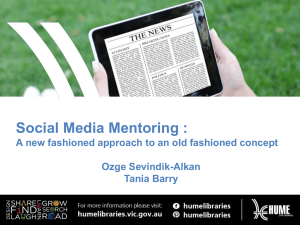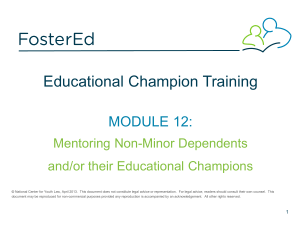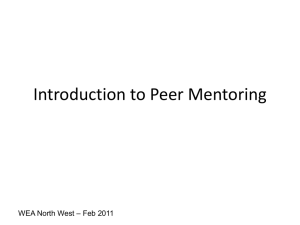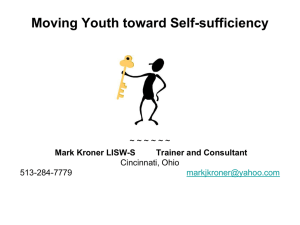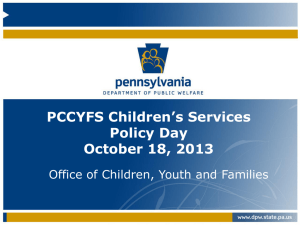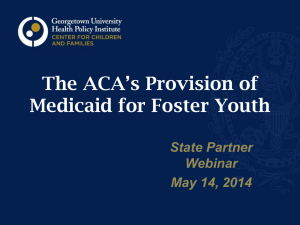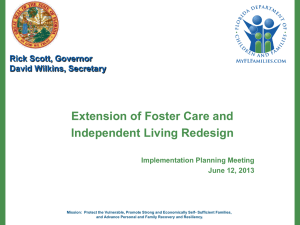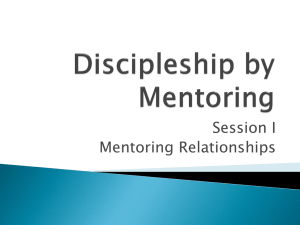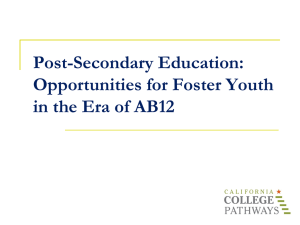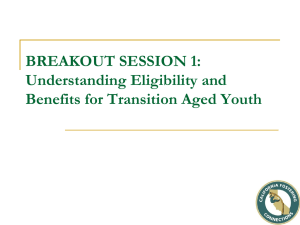Mentoring Foster Youth - SFUSD School Health Programs
advertisement
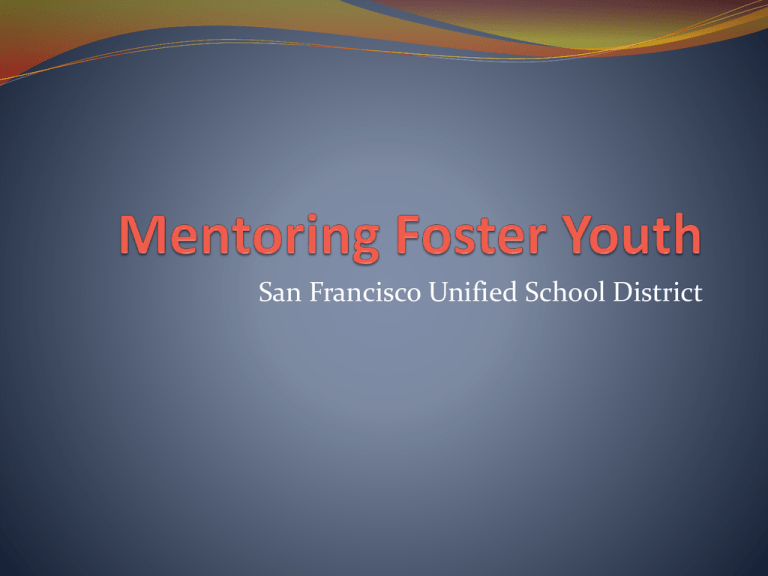
San Francisco Unified School District Introduction to Training This training was developed to support mentors interested in working with foster youth. Through a series of interactive activities you will have the opportunity to improve knowledge of effective strategies for supporting and empowering foster youth. The training will take about 45 minutes. Upon completion, please fill out the training evaluation by clicking on the link on the last page. Materials Required: - Pencil - 3 Sheets of Paper Learning Objectives Increase awareness about the unique needs of foster youth. Improve understanding of foster youth strengths and challenges. Increase awareness of the benefits of mentoring foster youth. Improve knowledge of strategies to support foster youth in mentoring programs. Ice Breaker – Change Exercise Take a close look at everything you are wearing. Now take the next minute to change 5 physical things about what you are wearing. (i.e., roll up sleeves, take off shoe) Without changing anything back, change 5 more things about what you are wearing. Once again, without changing anything back from the first two sets of changes, select 5 more things to change about what you are wearing. Please stop and move to the next page without changing anything back. Reflective Questions What did you notice about change? How did the changes make you feel? Why do you think we started with this activity when talking about foster youth? Change We like to begin with the change activity because, as you may have experienced, continuous change is often difficult. To enter the foster care system, youth go through numerous steps before their initial placement. The following slide describes the entry path for many of the foster youth that you will mentor. The entry process into the foster care system is complex, and requires that youth interact with numerous adults. Mike’s Story Part I Mike is seven years old, one of nine children all under the age of fifteen. He was raised by his grandmother who recently passed away and is currently residing in a single parent home with his mother. Mike’s mother suffers from severe mental illness and has been in and out of the home throughout his life. For the last three weeks Mike’s mom has been missing from his home and is unreachable. During his Mom’s disappearance, Mike has been periodically missing school. The next slide outlines the entry process into foster care. We will continue Mike’s story after the foster care entry slide. Please pay attention to the number of adults Mike comes in contact with during this process. Report filed about alleged abuse/neglect • Call screened and report prompts an Emergency Response Investigation Emergency Response Investigation • In-Person CPS Investigation • Evidence of abuse or neglect substantiated Child removed from home to short-term placement in protective services • Relatives identified • Child protection center • Court petition filed/Detention hearing (48 hours after child in custody) Team Decision Making Meeting (TDM) • Team determines “best fit” for placement, may be placed with relatives (ideally 1 day after removed from custody) Jurisdiction/Disposition Hearing (held within 15 days) • Child becomes a dependent of court • Family Maintenance or Reunification plan Placement options • Relative •Long term foster placement • Adoption •Residential treatment •Group home •Short-term foster care • Guardianship Mike’s Story Part II Once the school makes a CPS report due to unexcused absences, Mike begins to come into contact with a myriad of adults . The process starts with an investigation, and is followed by removal from his home due to founded neglect. He is then found family members to care for him, and a court hearing regarding guardianship is held, where the court decides if his mother is fit to parent. She discloses her mental illness, and a reunification plan is developed for Mike to return to his mother when her health is stabilized. Mike is placed in the custody of a relative, and then returned to his mother’s custody. Several scheduled follow up visits with the CPS Worker occur six months later. Pre - Removal 1. 2. 3. 4. Teacher Student Advisor , Principal, Secretary, or Attendance Clerk Emergency Response Worker CPS Worker (Assigned if case goes to court) Post –Removal 1. 2. 3. 4. 5. 6. 7. 8. 9. 10. 11. 12. Child Protection Shelter Worker(s) Non-Guardian Relatives Team Decision Making Meeting (TDM) Facilitator Translator (as needed) Community Based organization worker(s) (i.e. tutor, mentor, wraparound service provider) Judge Attorney Psychiatrist, Doctor Social worker/CPS Worker Court Appointed Special Advocate (if assigned) Therapist Foster Youth Services Liasion Foster Youth In 2007 approximately 496,000 foster youth were in care across the United States. California has the largest percentage of youth in foster care; the current count is at 100,000. Approximately 2300 youth emancipate (age out) in CA each year. California Foster Youth Everyday nearly 100 children in California enter foster care 54 will be reunified with their families, but 10 will re-enter care within 3 years 17 will stay in four years or more 11 will be adopted or permanently placed with relatives and 2 will re-enter within 3 years 10 will exit for “other reasons” – death, incarceration, institutionalization, abduction 4 will run away 3 will “age out,” or emancipate out of foster care San Francisco Foster Youth In San Francisco 340 youth emancipate each year 1 in 4 will end up homeless 70% will indicate they want to go to college Only 10% will enroll in college. 65% of the general population will enroll Only 4% will obtain an associate degree or certificate Only 2% of all emancipated youth will actually obtain a bachelor degree (HEY Stats Sheet) What is the role of a Mentor? Deep Listener – Really paying attention to the verbal and nonverbal information being passed. Reflection/Inquiry – Assisting mentee to reflect using inquiry. Feedback – Proving feedback to the mentee when requested. Sharing – Inserting yourself and giving examples of how you have done things. Support the mentee to move to next steps in developing new interest and skills. Attributes of a “Good Mentor”? Consistent Focuses on Good listener strengths ups and downs Flexible Zen Time to commit Not overly invested in Positive role immediate model change Positive Process attitude oriented Empathetic Present Understanding Open minded Caring Good energy Knowledge of systems Dedicated Can tolerate What are potential strengths & barriers foster youth bring to mentoring? Strengths Barriers Good at reading people Many rotating people in Lots of life experiences their life Move a lot Experienced adversity/hardships Walls up/Need to do things independently Survivors/Transferable skills Independent/mature Reflection Activity – Part 1 Think of a mentor that you had at any point in your life. Use the following activity to reflect on the relationship between you and that mentor. 1. Write down 5 barriers that your mentor might have faced when initially considering mentoring you (i.e., distance, class, work, substance dependence) 2. Now write down 5 strengths that they had that helped them to overcome the mentorship barriers Reflection Activity – Part 2 Now think of yourself as a mentor to a foster youth. 1. Write down 5 barriers that you as a mentor might face when initially considering mentoring (i.e., relationship – teacher/student, ethnicity) 2. Now write down 5 strengths that you have that will help you overcome the mentorship barriers Why Is Mentoring Important for Foster Youth? Mentoring programs: Reduce school absences Improve overall academic performance Increase college participation Improve attitudes and behavior in relation to school Reduce drug and alcohol use (especially among minority youth) Reduce likelihood of hitting others Less likely of committing misdemeanors or felonies Enhanced positive attitude toward elders and toward helping Improved parental relationships and support from peers Self Worth Herrera, C et.al, 2007) (Jekielek, S., Moore, K. & Hair, E. 2002) & (DuBois, DL, Holloway, BE, Valentine, JC, & Cooper, H., 2002) Strategies for Mentoring Foster Youth 1. Learning – Introduce youth to new experiences and activities. Provide opportunities for youth to have exposure to you as an individual, a large percentage of mentoring is all about watching. 1. Reflection – Provide time in your mentoring activities for the youth to have an opportunity to reflect. It is often during these reflection times that youth are able to gain ownership over a new skill or technique. Reflection helps build self awareness. 2. Action – Once youth have learned a new skill or technique mentors should give them the opportunity to test them out. This will allow the youth the opportunity to practice while mentors provide additional support. Discovering Learning Ideas for working with Youth Introduces youth to new experiences and activities. Hands on Activity – Helping mentees uncover areas of interest. 1. 2. 3. 4. 5. 6. 7. 8. Take a piece of flipchart paper and fold it in half and then in half again to form a book. Choose the title of a popular song for the name of your book. Write that title on the front cover. On the inside of the front cover (page two), list a table of contents. Write your name and birth date Description of your favorite color, animal, sport… On page three, draw a picture of your friends or family. On the back cover of the book, draw a picture of what you plan to do in the future. Where will you go? Who will you go with? Etc. When the book is complete, have the mentee tell their story, using the book as a visual aid. Encouraging Reflection Ideas for working with Youth Provide time in your mentoring activities for the youth to have an opportunity to reflect. Hands on Activity – Helping mentees develop reflection skills. You inherited a successful restaurant from Chef Charlie, a good friend. The only problem: Charlie was very disorganized. The only recipes you have found are on torn strips of paper. You have to make sense of it all, and quickly! The restaurant is opening tonight, and you have to have the food ready. Materials Needed Cut Recipes (Separate the Title, Ingredients, Instructions, etc.) Mentors should begin this activity by spreading the strips of recipe on the table Ask mentee to put steps in order as quickly as possible. The recipe must make sense. When done, have them announce “bon appetit!” to signal the end of the game. Once the mentee calls “bon appetit,” have them read/review their recipe in order. Ask them reflective questions about the process: What was your favorite part of the activity? What was your least favorite part of the activity? What was something new you learned/discovered? Was the activity something you would want to repeat? You may practice this activity by planning activities together. Write down all of the steps of an outing. (i.e., going to museum – select type of museum, get directions, travel…) Or supporting the youth to write down steps, put them in order, and check them off as you complete them. Supporting Action Ideas for working with youth Once youth have learned a new skill or technique mentors should give them the opportunity to test them out. Hands on Activity – Helping mentees discover strengths and talents. Take out a sheet of paper and write mentees name in the center and draw a large circle around name. Now connect six smaller circles with lines. In the six smaller circle ask mentee to name six or more activities or subjects in which they enjoy or feel confident. Next discuss how you might be able to build upon some of their strengths and talents during mentoring sessions. Now brainstorm a list of activities that would combine the skills developed during learning and reflection with the mentees natural talents. Final Reflection Activity Think of a specific foster youth Write down 5 barriers that they will face on their road to healthy adulthood. Write down 5 strengths that they have that will help them to overcome those barriers. Write down 5 positive mentor attributes/strengths you bring to the relationship. Write down 2 activity ideas you could do that build on both your strengths and will build skills for the youth Thank You! Please complete the training evaluation here https://www.surveymonkey.com/s/FYTraining If you would like more activity ideas go to www.healthiersf.org/mentoringforsuccess
